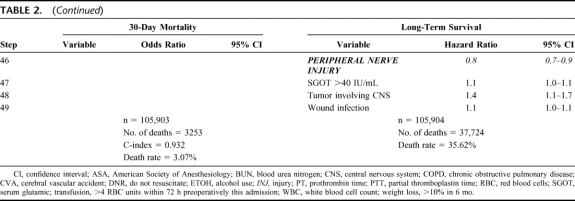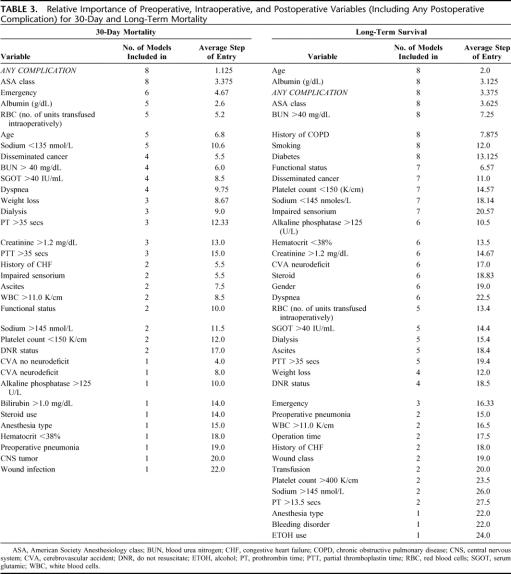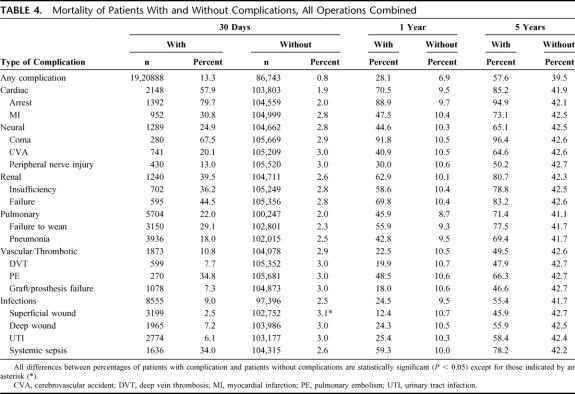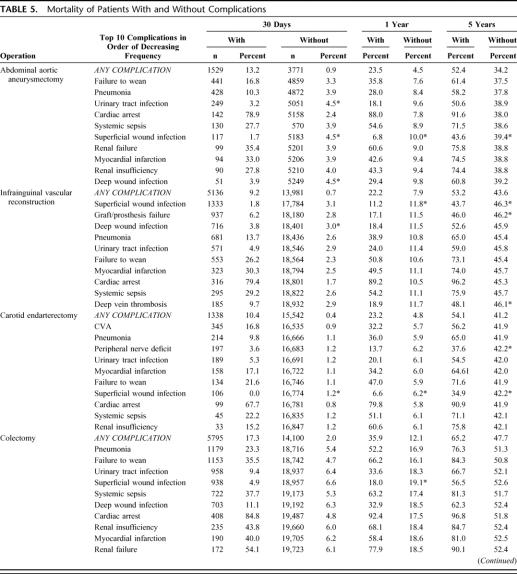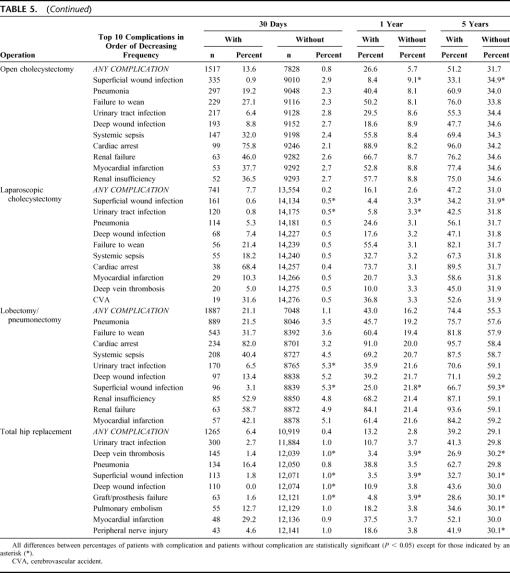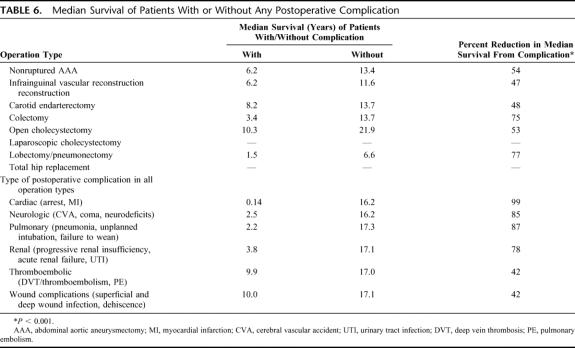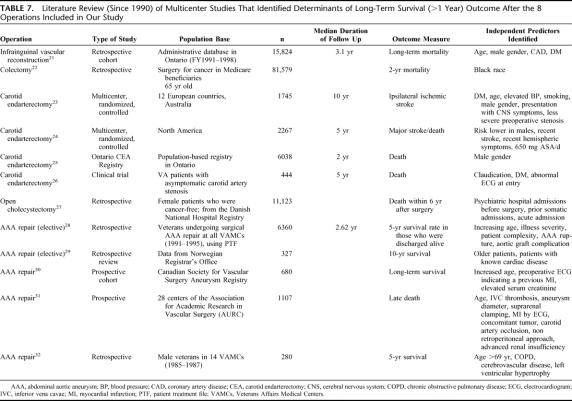Abstract
Objective:
The objective of this study was to identify the determinants of 30-day postoperative mortality and long-term survival after major surgery as exemplified by 8 common operations.
Summary Background Data:
The National Surgical Quality Improvement Program (NSQIP) database contains pre-, intra-, and 30-day postoperative data, prospectively collected in a standardized fashion by a dedicated nurse reviewer, on major surgery in the Veterans Administration (VA). The Beneficiary Identification and Records Locator Subsystem (BIRLS) is a VA file that depicts the vital status of U.S. veterans with 87% to 95% accuracy.
Methods:
NSQIP data were merged with BIRLS to determine the vital status of 105,951 patients who underwent 8 types of operations performed between 1991 and 1999, providing an average follow up of 8 years. Logistic and Cox regression analyses were performed to identify the predictors of 30-day mortality and long-term survival, respectively.
Results:
The most important determinant of decreased postoperative survival was the occurrence, within 30 days postoperatively, of any one of 22 types of complications collected in the NSQIP. Independent of preoperative patient risk, the occurrence of a 30-day complication in the total patient group reduced median patient survival by 69%. The adverse effect of a complication on patient survival was also influenced by the operation type and was sustained even when patients who did not survive for 30 days were excluded from the analyses.
Conclusions:
The occurrence of a 30-day postoperative complication is more important than preoperative patient risk and intraoperative factors in determining the survival after major surgery in the VA. Quality and process improvement in surgery should be directed toward the prevention of postoperative complications.
The Veterans Administration Beneficiary Identification and Records Locator Subsystem file was matched to the National Surgical Quality Improvement Program database to determine 8-year survival of 105,951 patients undergoing 8 types of operations. The occurrence of a 30-day postoperative complication, independent of preoperative risk and intraoperative factors, was found to be the most important determinant of patient survival after major surgery.
The National Surgical Quality Improvement Program (NSQIP) is the first national, validated, outcome-based, risk-adjusted, and peer-controlled program for measurement and enhancement of the quality of surgical care.1 To date, its prospectively collected database contains preoperative, intraoperative, and outcome information on more than 1.2 million major operations performed in more than 120 Department of Veterans Affairs (VA) inpatient surgical centers. Publications from the NSQIP (and the VA National Surgical Risk Study that preceded it) have identified preoperative predictors of 30-day mortality and 30-day morbidity after major surgery in all operations,2,3 in 8 surgical specialties,2,3 and in a variety of individual operations and procedure groups.4–13 A separate VA database, the Beneficiary Identification and Records Locator Subsystem (BIRLS) file, has been shown to contain reliable information on the vital status of all veterans with 87% to 95% sensitivity in recent years.14 Matching the NSQIP database with the BIRLS file provides a unique opportunity to assess the long-term survival of patients undergoing major surgery in the VA. Considering that an episode of surgical care is defined by a continuum of pre-, intra-, and postoperative factors and events, all of which have a potential impact on patient survival, this study merged the NSQIP database with the BIRLS file to determine the comparative impact of these factors and events on short- and long-term survival after major surgery.
METHODS
The National Surgical Quality Improvement Program and the Data Collection Processes
The VA National Surgical Quality Improvement Program (NSQIP) was begun in 1991 with the goal of developing risk-adjusted models for the prediction of surgical outcome that would allow the comparative assessment of quality of surgical care among multiple facilities.1–4,15 All 120 VA medical centers that perform major surgery participate in the program. At these facilities, all major operations performed under general, spinal, or epidural anesthesia are candidates for entry into the database. A surgical risk-assessment nurse is assigned at each center to collect the data. These nurses have completed in-depth training on conducting the protocol and in the variable definitions. Preoperative variables include patient demographics, comorbidities, laboratory values, and lifestyle variables. Intraoperative variables include Current Procedural Terminology (CPT) codes of the operations performed, wound classification, operative time, blood transfusion, and some characteristics of the surgeon. Postoperative outcomes include 30-day mortality and a list of 21 possible postoperative complications occurring within 30 days after the operation. For the purpose of this study, we included all operations of 8 different types (Table 1) from the NSQIP database with operation dates from 1991 to 1999. All patients were followed until 2003, giving an average follow up of 8 years.
TABLE 1. Study Population in the National Surgical Quality Improvement Program Database, Mortality Within 30 Days Postoperatively, and Mortality at Any Time During an Average Follow-up Period of 8 Years
The Beneficiary Identification and Records Locator Subsystem File
The BIRLS is a Veterans Benefits Administration (VBA) database. The file comprises approximately 44 million records, from pre-Civil War to the present, and almost 700,000 dependent records.14 Data fields in the BIRLS include date of birth and date of death. Cause of death information is too incomplete and rudimentary to use. Several studies have been conducted in recent years using known deaths of veterans to estimate the sensitivity of the BIRLS file.16–19 Based on these studies, and the facts that the present study was conducted in the period of 1991 to 2003 and mainly on inpatients, we expect that the sensitivity of the BIRLS file for the present study to be on the order of 87% to 95%. The NSQIP datafile for the 8 operations under study and for the period 1991 to 1999 was merged with the BIRLS file by using patient Social Security number. The date of death for each patient from the BIRLS file was recorded in the NSQIP datafile to create the database for this long-term mortality study.
Data Analysis
The relative importance of the patient preoperative characteristics, intraoperative variables, and postoperative complications on 30-day postoperative mortality was determined by stepwise multiple logistic regression analysis (lefthand side of Tables 2 and 3). Three models were run for each operation type and all operations combined. In the first model, only preoperative predictors were used. In the second model, the preoperative predictors significant in the first model were combined with intraoperative variables (operation time, anesthesia type, wound classification, and number of red blood cells transfused). In the third model, the preoperative and intraoperative predictors significant in the second model were combined with the postoperative complications to determine the final model. In each model, at step one, the most important predictor variable of 30-day postoperative mortality was entered. On the subsequent steps, the next most important variables were entered into the models, given that the previously entered variables were in the model. The regression analysis was discontinued when all important predictor variables were in the model at the P < 0.05 level of significance. Odds ratios and 95% confidence intervals for the odds ratios for each variable are given. The c-index is a measure of the predictability of the models. C-indices typically range between 0.5 and 1.0. As the c-index approaches 1.0, the predictability of the model improves. Models were developed for all operations combined (left side of Table 2) and the individual operations (left side of Table 3). The models for the individual operations are summarized in Table 3 by specifying the number of models in which each predictor variable was significant and the average step of entry in the stepwise analysis. The most important predictor variables are the ones that enter most or all of the models with a low number for average step of entry.
TABLE 2. Relative Importance of Predictors of 30-Day and Long-Term Mortality: All Operations (Postoperative Complications Capitalized, Bolded, and Italicized)
TABLE 2. (Continued)
TABLE 3. Relative Importance of Preoperative, Intraoperative, and Postoperative Variables (Including Any Postoperative Complication) for 30-Day and Long-Term Mortality
The relative importance of the patient preoperative characteristics, intraoperative variables, and postoperative complications on long-term mortality was determined by stepwise Cox regression analysis (right side of Tables 2 and 3). The stepwise Cox regression analysis works similarly to the stepwise logistic regression analysis, except the dependent variable is time to death rather than the dichotomous variable of alive or dead at 30 days postoperatively. Hazard ratios and 95% confidence intervals for the hazard ratios are given for each predictor variable. Models again were developed for all operations combined (right side of Table 2) and for the individual operations (right side of Table 3). The models for the individual operations are summarized in Table 3 by specifying the number of models in which each predictor variable was significant and the average step of entry in the stepwise analysis. The most important predictor variables are the ones that enter most or all of the models with a low number for average step of entry.
Thirty-day, 1-year, and 5-year mortality were calculated for patients with and without postoperative complications. These data are given for all operations combined for each type of complication and for any complication in Table 4 and for individual operations in Table 5. Mortality rates between patients with and without complications were compared using the chi-squared test.
TABLE 4. Mortality of Patients With and Without Complications, All Operations Combined
TABLE 5. Mortality of Patients With and Without Complications
TABLE 5. (Continued)
Kaplan-Meier survival curves were calculated for each type of operation (Fig. 1). A Cox model was fit with time to death as the dependent variable and preoperative and intraoperative variables as the independent variables. Patient risk-adjusted survival curves were then computed from the Cox model stratified on whether or not the patient experienced a postoperative complication (Fig. 2A). This analysis was repeated after deleting those patients who died in the 30-day postoperative period to determine if long-term mortality differences between patients with and without postoperative complications were the result of deaths in the immediate 30-day postoperative period (Fig. 2B). The Cox model was also fit and patient risk-adjusted survival curves were compared for patients with and without postoperative complications for each type of operation (Fig. 3; Table 6), and for categories of complications combining all types of operations together (Fig. 4; Table 6).
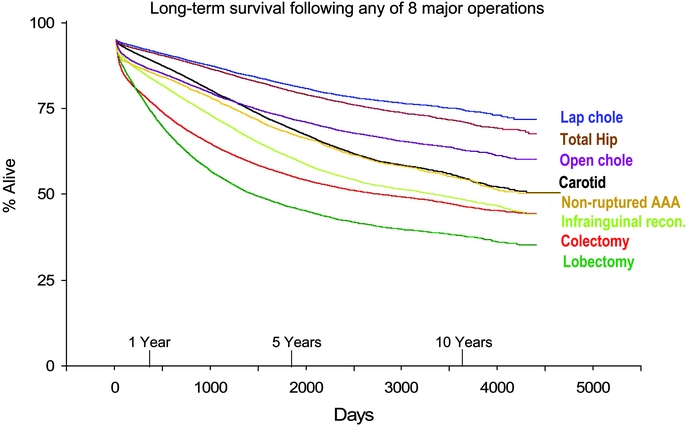
FIGURE 1. Kaplan-Meier survival curves of patients undergoing major surgery in the Veterans Affairs between 1991 and 2003, calculated for each type of operation included in the study.
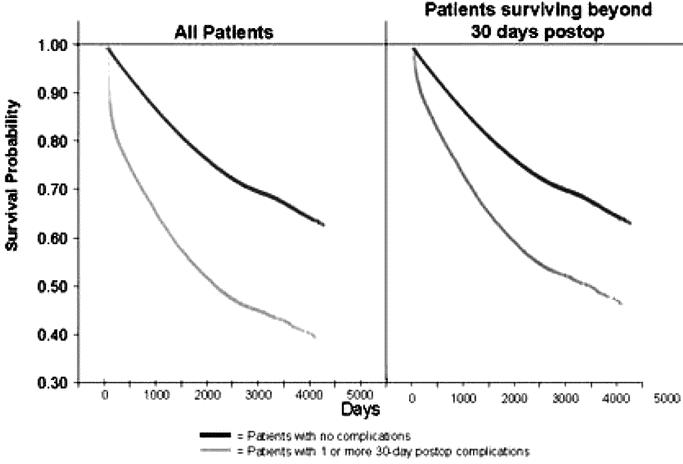
FIGURE 2. A, Cox survival curves of all study patients who sustained a 30-day postoperative complication compared with those who did not. B, Cox survival curves of study patients who survived 30 days after major surgery stratified as to whether or not patients had sustained a complication within the first 30 postoperative days. The difference in survival between the 2 groups in each panel reflects the independent effect of the occurrence of a postoperative complication on postoperative survival, ie, corrected for other confounding variables captured in the National Surgical Quality Improvement Program.

FIGURE 3. Cox survival curves of study patients undergoing abdominal aortic aneurysmectomy (A) and laparoscopic cholecystectomy (B) stratified as to whether or not patients had sustained a complication within the first 30 postoperative days. The difference in survival between the 2 groups in each panel reflects the independent effect of the occurrence of a postoperative complication on postoperative survival, ie, corrected for other confounding variables captured in the National Surgical Quality Improvement Program.
TABLE 6. Median Survival of Patients With or Without Any Postoperative Complication
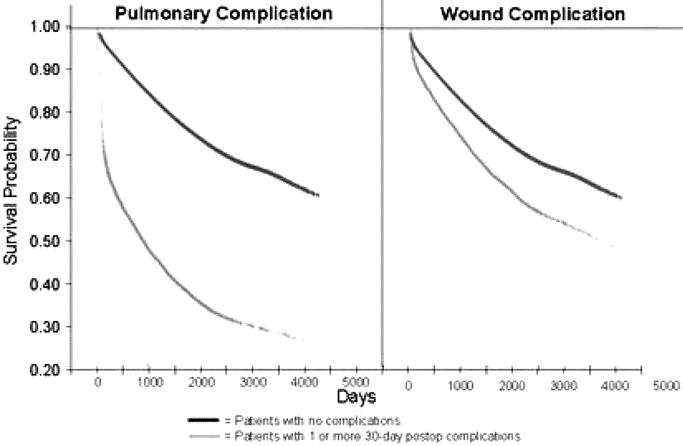
FIGURE 4. Cox survival curves of all study patients stratified as to whether or not the patients had sustained a pulmonary complication (A) or a wound complication (B) within the first 30 postoperative days. The difference in survival between the 2 groups in each panel reflects the independent effect of the occurrence of the respective complication on postoperative survival, ie, corrected for other confounding variables captured in the National Surgical Quality Improvement Program. Pulmonary complications include one or more of the following: pneumonia, prolonged intubation, and failure to wean. Wound complications include superficial wound infection, deep wound infection, and wound dehiscence.
RESULTS
Thirty-Day and Long-Term Survival After 8 Major Operations
The 30-day and long-term mortality rates after the 8 types of surgery included in this study are shown in Table 1. The overall 30-day mortality rate in the total study population was 3.07%; it varied from a low of 0.55% for laparoscopic cholecystectomy to a high of 6.51% for colectomy. With an average follow up of 8 years, mortality at any time in the follow-up period was observed to be 35.62% for the total population; it varied from 17.16% for laparoscopic cholecystectomy to 55.95% for pulmonary resection. Figure 1 shows the Kaplan-Meier survival curves after the 8 operations in the study. Long-term survival was best after laparoscopic cholecystectomy and worst after pulmonary resection.
Determinants of 30-Day and Long-Term Survival After 8 Major Operations
Table 2 lists the predictors of 30-day mortality and long-term survival for all operations in order of decreasing importance in the respective model. Of the top 12 independent predictors of 30-day mortality, 7 were postoperative complications: cardiac arrest, failure to wean, systemic sepsis, cerebrovascular accident (CVA), renal failure, myocardial infarction (MI), and renal insufficiency. The 5 preoperative variables among the top 12 determinants of 30-day mortality (preoperative serum albumin level, ASA class, emergency status, disseminated cancer, and age) were the same as the top preoperative predictors of 30-day mortality that were identified in our previous studies.2,20 As shown in Table 2, individual complications occurring in the first 30 days postoperatively were also independent determinants of long-term survival, but their relative importance in the model was less than that in the 30-day mortality model. These findings, which were observed in the all-operation models, were similar to the findings observed in individual operation models (data not shown). For example, the top 3 independent determinants of 30-day mortality after laparoscopic cholecystectomy were complications (cardiac arrest, CVA, and renal failure), and 6 of the top 10 predictors in this model were complications. Of the top 6 predictors of long-term survival after laparoscopic cholecystectomy, 2 were complications (cardiac arrest and failure to wean).
Table 3 depicts the relative importance of preoperative, intraoperative, and postoperative variables in all 8 individual operation models. Complications were grouped into a single dichotomous variable, the presence or absence of any complication. The presence of any complication within the first 30 days postoperatively was the most important independent determinant of 30-day mortality; it appeared in all 8 models with an average step of entry of 1.12. It was also the third most important predictive variable of long-term survival, also appearing in all 8 models with an average step of entry of 3.4. Age was the most important determinant of long-term survival in contrast to 30-day mortality in which it was the sixth most important determinant, appearing in 5 of the 8 models. Intraoperative variables were not as important as complications and preoperative risk factors in determining survival after major surgery. Of these, only the need for intraoperative transfusion appeared in 5 of the 8 individual operation models, and it was not among the 12 top predictors in any model.
The Effect of 30-Day Postoperative Complications on Long-Term Survival
These analyses identified an important independent predictive role of complications in short- and long-term survival after major surgery. To explore this relationship further, we conducted a more detailed analysis of outcomes in patients who sustained 30-day postoperative complications compared with patients who did not. Table 4 lists the mortality of patients with and patients without 30-day complications in the whole study population, examining the impact of specific complications on mortality at 30 days, at 1 year, and at 5 years postoperatively. Differences in mortality rates at these 3 periods in time between patients with and without 30-day postoperative complications were all significant, except for superficial wound infection at 30 days postoperatively. Patients experiencing a complication of any type within the first 30 days postoperatively had a 30-day mortality rate of 13.3% compared with a rate of 0.8% observed in the patients who did not have a postoperative complication (P < 0.001). At 1 and 5 years postoperatively, the mortality rate in the patients with a complication of any type was 28.1% and 57.6%, respectively, in contrast to 6.9 and 39.5% (P < 0.001 and P < 0.001, respectively) in patients with no complications. The mortality rates at 30 days, 1 year, and 5 years postoperatively in patients with 30-day complications varied with the type of complication. For example, myocardial infarction resulted in a mortality rate of 31% at 30 days, 47% at 1 year, and 73% at 5 years. In contrast, a urinary tract infection resulted in corresponding mortality rates of 6%, 25%, and 58%.
The impact of specific complications and groups of complications on mortality at 30 days, 1 year, and 5 years postoperatively in each of the 8 study operations is shown in Table 5. The impact of a specific complication on mortality over time varied from one procedure to another, although inconsistently. Pneumonia and MI consistently exhibited a significant effect on all 3 mortality time points in all operations. In contrast, superficial wound infection exhibited a significant effect on 30-day mortality in only 3 of the 8 operations (infrainguinal vascular reconstruction, colectomy, open cholecystectomy) and did not exhibit a significant effect on 1- and 5-year mortalities in any of the 8 operations.
Survival Curves of Patients With 30-Day Postoperative Complications
Figure 2A depicts the Cox regression survival curves of the total study population separated on the basis of whether or not the patient had sustained a 30-day postoperative complication. The curves represent the independent effect of the presence or absence of a 30-day postoperative complication, accounting for all the other confounding variables. The difference between the 2 survival curves in this figure was highly significant, with the median survival of patients with and those without a complication being 5.6 and 18.4 years, respectively (P < 0.001). Thus, the occurrence of a 30-day postoperative complication of any type reduced the median long-term survival in our study population by 69%. To ascertain that the difference in long-term survival between the 2 groups was not solely the result of the initial 30-day postoperative mortality, similar Cox regression survival curves were constructed first deleting the patients with 30-day postoperative mortality. The resultant curves, shown in Figure 2B, confirmed the independent effect of a 30-day postoperative complication on long-term survival: The patients who developed a complication and survived beyond 30 days postoperatively had a median survival of 9.6 years, compared with a median survival of 18.4 years (P < 0.001) in patients who did not develop a 30-day postoperative complication and who also survived beyond 30 days postoperatively.
Median survival by extrapolating the Cox regression curves could be determined in 6 of the 8 operations. The same significant effect of a 30-day complication causing a reduction in median patient survival was observed in these 6 operations (Table 6). The occurrence of a complication within 30 days after these operations reduced the median survival by 47% to 77%. Figure 3 illustrates this effect in 2 examples, abdominal aortic aneurysmectomy and laparoscopic cholecystectomy. In both, significant differences are observed between the survival curves of patients who sustained a 30-day postoperative complication of any type and those who did not.
Survival in patients who sustained a specific 30-day postoperative complication category was significantly less than that of patients who did not sustain a complication in that category (Table 6). The reduction in median survival independently attributed to specific complication groups ranged from 42% for wound complications to 99% for cardiac complications. This is illustrated in Figure 4, which depicts the Cox survival curves after the 2 most frequent groups of complications, pulmonary and wound. In both categories, significant differences in survival were observed between those who sustained the complications and those who did not (P < 0.001 for pulmonary and P < 0.001 for wound complications).
The long-term survival curves of patients who sustained a 30-day postoperative complication consistently exhibited 2 different slopes, the initial slope being more acute than the latter slope (Fig. 5). The inflection point between the 2 slopes ranged between 27 days for hip replacement and 180 days for carotid endarterectomy.

FIGURE 5. Survival curve of patients undergoing colectomy who developed one or more complications in the first 30 days postoperatively showing the 2 slopes of the curve and the inflection point. The inflection points for the 8 procedures studied are shown in the table insert.
DISCUSSION
This is the first prospective multicenter study that identifies the predictors of 30-day and long-term survival after major surgery, taking into account the compendium of pre-, intra-, and postoperative variables that define an episode of surgical care. The study shows that events in the postoperative period are more important than preoperative patient risk factors in determining the survival after major surgery in the VA. Specifically, after correcting for the confounding variables collected in the NSQIP, the occurrence of a complication within the first 30 days postoperatively, independent of the patient's preoperative risk, reduced median patient survival by 69% in the total patient study group.
Multicenter studies published since 1990 that have addressed the predictors of survival at and beyond 1 year after the 8 operations addressed in this study have been scarce (Table 7). Most have been retrospective in nature and based on clinical registries or administrative and claims databases. They all focused primarily on preoperative variables with most of them concentrating on disease-specific variables. None of the published studies to date has provided an assessment of the relative contribution of pre- and postoperative factors in determining postoperative survival. In our study, we used generic and not disease-specific preoperative variables and found that the predictive variables for each operation (data not shown in the article) were similar to those identified in the all-operations model shown in Table 2. Most striking in these models and in the models shown in Table 3 was the relative importance of postoperative complications in independently determining both postoperative 30-day mortality and long-term survival after major surgery. In a recently published case–control study in which cases were randomly selected from the Pennsylvania Medicare database, Silber et al were first to demonstrate an altered prognosis of patients experiencing their first postoperative complication compared with patients who had not been reported to experience a complication.33 They reported a 3.4-fold increase in the odds of dying within 60 days postoperatively in patients with complications as compared with those without complications. However, because of the limitations inherent in that study (patient selection based on claims data, retrospective chart review, case–control design, follow up limited to 60 days, small sample size), it could not separate with certainty the effect of the complication per se from that of preoperative patient risk and other important determinants of postoperative long-term survival. In contrast, our study used a large sample size in a prospective database populated in a standardized fashion by dedicated nurse reviewers and containing complete data on pre-, intra-, and postoperative variables, including laboratory variables, with a vital status follow up of an average of 8 years postoperatively. This allowed us to ascertain the independent effect of the occurrence of a 30-day postoperative complication on long-term survival. Hence, the survival curves shown in Figures 2 to 4 display differences in survival between patient groups that are primarily the result of the presence or absence of a complication, ie, corrected for other confounding variables collected in the NSQIP. As shown in Figure 4 and reported in Table 6, the occurrence of pulmonary complications in the study population independently reduced the median survival by 87%, and the occurrence of a wound complication independently reduced the median survival by 42%. Equally noteworthy in our study are the seemingly high mortality rates at 5 years postoperatively in patients who did not experience specific complications within 30 days after certain operations (infrainguinal vascular reconstruction, 43.6%; carotid endarterectomy, 41.2%; colectomy, 47.7%; pulmonary resection 55.3%). Because there are no other prospective observational multicenter studies that have addressed postoperative long-term mortality in this manner, it is difficult to compare these figures to the published literature. In general, the 5-year mortality rates after these operations as reported in few large, single, institutional studies and prospective, randomized, multicenter trials are lower than the rates reported in this study. It is unlikely that this high late mortality rate is unique to the VA patient population. We have just completed a large multicenter study that examined the applicability of the NSQIP to the private sector. Unpublished data from this study, as well as data from a smaller previously published study,34 indicate that surgical outcomes of general and vascular surgery in VA medical centers are similar to outcomes in major academic non-VA medical centers.
TABLE 7. Literature Review (Since 1990) of Multicenter Studies That Identified Determinants of Long-Term Survival (>1 Year) Outcome After the 8 Operations Included in Our Study
In the regression analyses, occasionally an odds ratio or hazard ratio was below one for a postoperative complication, indicating a “protective” effect for mortality (eg, in Table 2, the odds ratio for deep wound infection is 0.6 for 30-day mortality). We know from Table 4 that patients with a deep wound infection have higher 30-day mortality compared with those without this complication (7.2% vs 3.0%, P < 0.05). This is an occasional artifact that happens in regression analysis, particularly when some very important variables dominate the model (eg, cardiac arrest with an odds ratio of 125.0).
It is surprising (and almost counterintuitive to surgeons) to note that the adverse impact of 30-day postoperative morbidity on long-term survival is not only the result of the mortality within 30 days as shown in Figure 2. Complications such as pneumonia, deep wound infection, and pulmonary embolism, even after apparent recovery, still result in a shortened lifespan. It is difficult to fully explain this phenomenon with our current state of knowledge. An abundant literature demonstrates the occurrence of immediate systemic inflammatory responses (SIRS) in proportion to the duration and magnitude of surgical interventions,35–37 trauma,38,39 anesthesia,40 and early cardiac complications.41 Markers of these responses include elevated cytokine levels with extended duration of elevation; among these markers are IL 1b, IL 6, IL 10, and C-reactive protein (CRP). Elevated levels of IL 6 and CRP relate to myocardial infarction41 and can also predict myocardial infarction in asymptomatic men.42 Myocardial events per se appear to be prominent determinants of long-term survival. Continued elevation of cardiac troponin elevations after major vascular surgery in asymptomatic patients43 is associated with a decrement in long-term survival (P = 0001) over a 6-year period. Long-term persistence of inflammatory states or their effects after operations, complications, and other critical illnesses may be a factor in shortening postoperative survival because certain interventions have been shown to reduce these effects. For example, continuance of statins and beta-blockers, independently, has been shown to diminish long-term mortality after vascular and cardiac surgery.44,45 The precise mechanisms with which inflammatory states can lead to decreased long-term survival remains to be determined. A recent study that showed an adverse effect of intraoperative myocardial acidosis on long-term survival after cardiac surgery46 hypothesized acidosis-induced acceleration of apoptosis47 might be an underlying mechanism. It is thus tempting to hypothesize that the inflammatory states after operations and complications may also lead to accelerated apoptosis and subsequent decrease in long-term survival.
The demonstration of an adverse effect of complications on long-term outcome, independent of the patients’ preoperative risk, has important implications on quality improvement of surgical care. First and foremost, it prompts that process improvement efforts be directed toward the prevention of postoperative complications. Complications are preventable through process improvement, as evidenced by the 45% reduction in postoperative morbidity that was observed within 5 years after the institution of the NSQIP in the VA.15 The feedback of comparative risk-adjusted outcomes to surgical providers in the VA has been instrumental in promoting process improvement at the local level48; the NSQIP annual report has many examples of institutions that witness a significant decrease in morbidity observed/expected ratio secondary to local process improvement (Fig. 6). Second, reducing the postoperative complication rate also reduces the cost of surgical care. The NSQIP in both the VA (work in progress) and the private sector49 has demonstrated a 5-fold increase in the median cost of an operation in general surgery when that operation is accompanied by a postoperative pulmonary complication. Third, the inflection point of the survival curve of patients with complications (Fig. 5) suggests that a follow-up period longer than 30 days is required for one to assess completely the impact of an episode of surgical care on patient outcome. It also emphasizes the deficiency of using in-hospital morbidity and mortality as measures of quality of care. Finally, this study underscores the important role of risk-adjusted outcomes in the measurement and enhancement of the quality of surgical care, and the imperative of developing standardized, prospective, and reliable methods to measure them.50

FIGURE 6. Time course of the observed to expected (O/E) 30-day morbidity ratio in the all-operations model over 4 fiscal years in 2 separate Veterans Affairs medical centers. A statistically significant high outlier at the 99% confidence level is indicated by the asterisk (*) and a statistically significant low outlier is indicated by the pound sign (#). (A; hospital A) This hospital was a low outlier in FY 01; the morbidity rate increased over the next 2 years, mostly in general surgery and orthopedics, causing it to become a high outlier in FY 03. Process improvement reversed the overall O/E ratio, but although it ceased to be an outlier in the all operations model and general surgery, it continued to be a high outlier in orthopedics, indicating that additional process improvement needed to be directed toward orthopedic surgery at that hospital. (B; hospital B) This hospital was a high outlier in morbidity for 3 consecutive years. Negative press about the quality of care at that hospital prompted process improvement that resulted in a marked decrease in morbidity rate from 17.5% to 10.8%. These 2 case studies exemplify the fact that surgical morbidity rates can be reduced effectively through local process improvement.
Discussions
Dr. John L. Cameron (Baltimore, Maryland): I would like to congratulate Dr. Khuri on another outstanding presentation of very interesting, but also somewhat puzzling data. The major part of Dr. Khuri's presentation is intuitive. After an operation if you have a stroke, a myocardial infarct, a cardiac arrest, develop renal failure, compared to the group that doesn't have those complications, long-term survival is less. That really is intuitive, and if that was the whole presentation, there would be no discussion.
However if the same thing held true for complications such as pulmonary emboli, pneumonia, urinary tract infection, and even wound infections, that would be unusual, and that is in fact what Dr. Khuri has shown.
Therefore the major question is, does the decrease in long-term survival results from the complication, or are these minor complications just surrogate markers for something else that really determines, and decreases long-term survival. For instance, with a wound infection, does that result in immunosuppression of the patient and make more likely implantation of tumor cells shed during surgery? Or is the increase in the systemic inflammatory response that accompanies the wound infection, initiate a cascade of events that leads to progression of atherosclerosis? Or do these minor complications result in nutritional depletion, perhaps delayed adjuvant therapy, or cause other delays in recovery that result in a decrease in long-term survival?
Or is the complication just a surrogate marker for something else, and this something else is the cause of the complication as well as the cause of the decrease in long-term survival? So these are interesting, but also somewhat puzzling data.
Unfortunately we don't have any information from Dr. Khuri's presentation, or even from the manuscript, about the diagnoses for which these operations were carried out. For instance, for the colon are they all cancers, or are there a lot of patients with diverticular disease? This obviously is important information to know. We also need to know the cause of death. In patients with colon cancer, is the increased mortality rate secondary to an increase in cancer recurrence, or are they secondary to atherosclerotic disease, or other causes?
Finally, I want to comment and ask Dr. Khuri to comment on something that wasn't in his presentation, but is 1 of the most interesting parts of the manuscript. The survival curves after all of the operations presented by Dr. Khuri assume 2 shapes. One is a sharp drop immediately postoperatively, which is the postoperative mortality. And then the inflection point where the curve assumes the normal survival curve for that age group. We have always assumed that 30-day mortality ends the mortality point for the operation, and we report hospital or 30-day mortality. The inflection point however for the 8 operations that Dr. Khuri discusses are in most instances much further out than 30 days. For instance for abdominal aneurysms the inflection point is at 97 days. For carotid endarterectomy they don't assume the normal survival curve until 180 days. Why is this inflection point so late, Dr. Khuri? What is the explanation for that? And what could we do in these instances where the normal survival curve isn't assumed until weeks or months later, to initiate the inflection point earlier?
These data are very interesting, raise many important questions, and certainly at first glance are very puzzling. There are many questions generated by these data that Dr. Khuri has presented to keep Dr. Khuri busy for many years to come.
Dr. Shukri F. Khuri (West Roxbury, Massachusetts): Thank you very much, Dr. Cameron. I think you are as puzzled with these findings now as we were when we first generated the data. As to whether the effect of complications on long-term outcome is a surrogate for something else, our statisticians assure us that the effect of the complication is independent of the preoperative risk factors and intraoperative events. In and of itself, the complication probably initiates some cascade of events that ultimately alter the survival of the patient. There is enough evidence in the literature to suggest that complications initiate an inflammatory process, which I think may be leading to certain events that ultimately decrease patient survival. We have some evidence from our own laboratory in cardiac surgery that might shed some light on this issue. In a group of nearly 500 patients who were followed up for an average of 10 years, we have shown that intraoperative myocardial acidosis independently decreases long-term survival following cardiac surgery. We have also shown a direct relationship between intraoperative myocardial acidosis and accelerated myocyte apoptosis. It is therefore attractive to hypothesize, apropos this study, that the complication-induced inflammatory processes might be accelerating apoptotic processes, which in turn might influence long term survival. Obviously, a lot of basic work is needed to verify such a hypothesis.
I did not have time in my presentation to address the inflection point that you mentioned. This was certainly an interesting new finding wherein the survival curves of the patients with complications all seemed to have two components to them, an initial curve with an acute slope followed by a curve with a milder slope. The inflection point where the 2 slopes met corresponded to a time point that ranged between 27–180 days with an average of 81 days postoperatively, in the 8 operations studied. This probably indicates that the immediate postoperative effects of a single episode of care are not adequately appreciated with a follow up of only 30 days postop. A much longer period of follow-up probably up to 180 days, is probably needed to appreciate the full effect of a single episode of care on short term patient outcome.
Dr. Jonathan L. Meakins (Oxford, England): There is a certain feeling of disconnect between Papers 3 and 4. In 3, we hear that the cost to society, which is the cost in dollar terms, is actually related to the preoperative risk factors and surgical complexity and only 4 percentage points are related to postoperative complications. Yet in this paper, the cost to the patient is almost entirely linked to postoperative complications without reference to preoperative risk factors.
So I am having a little trouble sorting out the message if in one sense preoperative issues and surgical complexity are really much more important to the length of stay and the dollar cost to the patient, yet to the patients themselves, the postoperative complications are most significant. In other work you have told us that outcome (morbidity and mortality) is associated with preoperative assessment. Therefore, the issues in these 2 presentations must all be related. So how are we to think about these 2 different kinds of costs and what they mean to society and to the patient?
Dr. Shukri F. Khuri (West Roxbury, Massachusetts): They are all related. The 2 papers we presented this morning are not contradictory but in fact complimentary to one another. One has to think in terms of an episode of surgical care wherein the patient brings in a multitude of preoperative risk factors and undergoes an operation of varying complexity. Although complications are more likely to occur in patients with more risk factors undergoing more complex operations, the number of patients who experience a complication in a good surgical center is relatively low, compared to the majority of patients who do not experience a complication. Therefore, as we have heard from Mr. Davenport and Dr. Mentzer, the overall cost of treating a population of surgical patients is determined more by the postoperative severity of illness of the 85% of patients who do not experience a complication than by the cost of 15% of patients who do develop a postoperative complication. This does not mean that the complications are not costly or that complications cannot exert an adverse effect on long term survival.
Prof. J. Hans Jeekel (Rotterdam, Netherlands): It may have to do something with the defense mechanism in the patients. If you look at, for example, the strong evidence that we have nowadays that the acute inflammatory response may influence as well as postoperative infection as well as tumor growth exponentially. Do you have data of cancer recurrence in the long-term follow-up and recurrence of inflections in the long-term follow-up in order to get some impression about indeed the immune–or the defense mechanism that has to do with the acute inflammatory response and subsequent tumor recurrence.
Dr. Shukri F. Khuri (West Roxbury, Massachusetts): It is unfortunate that although we have excellent data on the vital status of the US veterans in the BIRLS file, the file does not provide information on the cause of death of our patients. Therefore, we cannot tell how many of the deaths were due to cancer. However, we have specifically chosen to study some operations that do not necessarily involve cancer, like infrainguinal vascular reconstruction and abdominal aortic aneurysmectomy. The observations we made on the effect of complications in these operations were similar to those we made in operations that were likely to include cancer patients, such as colectomy and pulmonary resection. However, your point is well made in terms of the effects of the immune system and the inflammatory process. Probably this is where research needs to go to answer the questions raised by our study.
Dr. Murray F. Brennan (New York, New York): Dr. Khuri, I enjoyed your paper, as I have enjoyed many of your presentations. But I am left with an extraordinary dilemma, a sort of sinking feeling of therapeutic nihilism.
You tell us that the only event I could see, that relates to the operation was wound infection. Did antibiotics make any difference? The rest were system failures, systemic failures, and yet you told us that preoperatively we could not predict those. So I am left with this extraordinary feeling that the only thing I can possibly impact on is wound complications. Perhaps you would reassure me?
Dr. Jeekel is correct, what we need is disease-specific survival, which would answer many of these questions. Finally, Dr. Cameron's reason for commenting is there are no complications at the Johns Hopkins Hospital.
Dr. Shukri F. Khuri (West Roxbury, Massachusetts): We have devoted a good section of our manuscript addressing the issue of whether or not one can reduce complications. In the manuscript we present data from the NSQIP that clearly show how process improvement at the local level can dramatically improve the morbidity O/E ratio of a specific surgical center and of specific specialties within that center. This demonstrates what has been established by the NSQIP for more than a decade, namely that feed back to the provider of reliable comparative risk-adjusted outcomes is an effective tool for driving process and quality improvement in surgery at both local and national levels.
Dr. Bruce H. Barraclough (Sydney, Australia): A great paper from a very important project. With the methodologies used in the VA to do a root cause analysis to identify the basic underlying systems causes for these things, could you tell us what percentage of these complications you would find as preventable and what are the top issues in terms of systems improvement that would allow us to make those that are preventable actually be preventable?
Dr. Shukri F. Khuri (West Roxbury, Massachusetts): Every year we review the O/E ratios for mortality and morbidity in all 122 surgical centers in the VA. The O/E, or observed to expected, ratio is the risk adjustment measure used to compare the performance of one hospital to another in our system. For morbidity, it is calculated at the 99% confidence level. We repeatedly see surgical centers and specialties within these centers, who are statistically significant high outliers in a certain year (i.e. performing poorly) improve significantly within one year, with a marked drop in the O/E ratio, sometimes to a statistically low outlier status. This means that they have effectively reduced the risk-adjusted number of complications, mostly through process improvement. So yes, within the rubric of process improvement, morbidity can be reduced and as such complications resulting from suboptimal processes of care can be prevented. Based on the wide variation in morbidity O/E ratio which we observe between various institutions, I personally believe that the majority of complications can be prevented through improved processes of care.
Footnotes
The opinions expressed here are those of the authors and not necessarily those of the Department of Veterans Affairs or the U.S. Government.
Reprints: Shukri F. Khuri, MD, Surgical Servicem, VA Boston Healthcare System, 1400 VFW Parkway, West Roxbury, MA 02132. E-mail: shukri.khuri@med.va.gov.
REFERENCES
- 1.Khuri SF, Daley J, Henderson WG, et al. The National Veterans Administration Surgical Risk Study: risk adjustment for the comparative assessment of the quality of surgical care. J Am Coll Surg. 1995;180:519–531. [PubMed] [Google Scholar]
- 2.Khuri SF, Daley J, Henderson WG, et al. Risk adjustment of the postoperative mortality rate for the comparative assessment of the quality of surgical care: results of the National Veterans Affairs Surgical Risk Study. J Am Coll Surg. 1997;185:315–327. [PubMed] [Google Scholar]
- 3.Daley J, Khuri SF, Henderson WG, et al. Risk adjustment of the postoperative morbidity rate for the comparative assessment of the quality of surgical care: results of the National Veterans Affairs Surgical Risk Study. J Am Coll Surg. 1997;185:328–340. [PubMed] [Google Scholar]
- 4.Khuri SF, Daley J, Henderson WG, et al. The Department of Veterans Affairs’ NSQIP. The first national, validated, outcome-based, risk-adjusted, and peer-controlled program for the measurement and enhancement of the quality of surgical care. Ann Surg. 1998;228:491–507. [DOI] [PMC free article] [PubMed] [Google Scholar]
- 5.Longo WE, Virgo KS, Johnson FE, et al. Outcome following proctectomy for rectal cancer in Department of Veterans Affairs Hospitals: A report from the National Surgical Quality Improvement Program. Ann Surg. 1998;228:64–70. [DOI] [PMC free article] [PubMed] [Google Scholar]
- 6.Harpole DH, DeCamp MM, Daley J, et al. Prognostic models of 30-day morbidity and mortality after major pulmonary resection. J Thorac Cardiovasc Surg. 1999;117:969–979. [DOI] [PubMed] [Google Scholar]
- 7.Longo WE, Virgo KS, Johnson FE, et al. Outcome following colectomy for colon cancer in the Department of Veterans Affairs: a report from the National Surgical Quality Improvement Program. Dis Colon Rectum. 2000;43:83–91.10813129 [Google Scholar]
- 8.Corman JM, Penson DF, Hur K, et al. Comparison of complications after radical and partial nephrectomy: results from the National VA Surgical Quality Improvement Program. Br J Urol Intern. 2000;86:782–789. [DOI] [PubMed] [Google Scholar]
- 9.Weaver F, Hynes D, Goldberg J, et al. Hysterectomy rates, trends, and outcomes in VA Medical Centers—a six-year review. Obstet Gynecol. 2001;97:880–884. [DOI] [PubMed] [Google Scholar]
- 10.Feinglass J, Pearce WH, Martin GJ, et al. Postoperative and late survival outcomes after major amputation: findings from the Department of Veterans Affairs National Quality Improvement Program. Surgery. 2001;130:21–29. [DOI] [PubMed] [Google Scholar]
- 11.Grossman EM, Longo WE, Virgo KS, et al. Morbidity and mortality of gastrectomy for cancer in the Department of Veterans Affairs Medical Centers. Surgery. 2002;131:484–490. [DOI] [PubMed] [Google Scholar]
- 12.Billingsley KG, Hur K, Henderson WG, et al. Outcome after pancreaticoduodenectomy for periampullary cancer: an analysis from the Veterans Affairs National Surgical Quality Improvement Program. J Gastrointest Surg. 2003;7:484–491. [DOI] [PubMed] [Google Scholar]
- 13.Margenthaler J, Longo WE, Virgo KS, et al. Risk factors for adverse outcomes following appendectomy for appendicitis in adults. Ann Surg. 2003;238:59–66. [DOI] [PMC free article] [PubMed] [Google Scholar]
- 14.Cowper DC, Kubal JD, Maynard C, et al. A primer and comparative review of major US mortality databases. Ann Epidemiol. 2002;12:462–468. [DOI] [PubMed] [Google Scholar]
- 15.Khuri S, Daley J, Henderson WG. The comparative assessment and improvement of quality of surgical care in the Department of Veterans Affairs. Arch Surg. 2002;137:20–27. [DOI] [PubMed] [Google Scholar]
- 16.Fisher SG, Weber L, Goldberg J, et al. Mortality ascertainment in the veteran population: alternatives to the National Death Index. Am J Epidemiol. 1995;141:242–250. [DOI] [PubMed] [Google Scholar]
- 17.Page WF, Braun MM, Caporaso NE. Ascertainment of mortality in the US veteran population: World War II veteran twins. Mil Med. 1995;160:351–355. [PubMed] [Google Scholar]
- 18.Boyle CA, Decoulfe P. National source of vital status information: extent of coverage and possible selectivity in reporting. Am J Epidemiol. 1990;131:160–168. [DOI] [PubMed] [Google Scholar]
- 19.Dominitz JA, Maynard C, Boyko EJ. Assessment of vital status in Department of Veterans Affairs national databases: comparison with state death certificates. Ann Epidemiol. 2001;11:81–86. [DOI] [PubMed] [Google Scholar]
- 20.Gibbs J, Cull W, Henderson WG, et al. Preoperative serum albumin level as a predictor of operative mortality and morbidity: results from the National VA Surgical risk Study. Arch Surg. 1999;134:36–42. [DOI] [PubMed] [Google Scholar]
- 21.Al-Omran M, Tu JV, Johnston W, et al. Outcome of revascularization procedures for peripheral arterial occlusive disease in Ontario between 1991 and 1998: a population-based study. J Vasc Surg. 2003;38:279–288. [DOI] [PubMed] [Google Scholar]
- 22.Cooper GS, Yuan Z, Landefeld CS, et al. Surgery for colorectal cancer: race-related differences in rates and survival among Medicare beneficiaries. Am J Public Health. 1996;86:582–586. [DOI] [PMC free article] [PubMed] [Google Scholar]
- 23.Cunningham EJ, Bond R, Dphil M, et al. Long-term durability of carotid endarterectomy for symptomatic stenosis and risk factors for late postoperative stroke. Stroke. 2002;33:2658–2663. [DOI] [PubMed] [Google Scholar]
- 24.Barnett HJM, Taylor DW, Eliasziw M, et al. Benefit of carotid endarterectomy in patients with symptomatic moderate severs stenosis. N Engl J Med. 1998;339:1415–1425. [DOI] [PubMed] [Google Scholar]
- 25.Kapral MK, Wang H, Austin PC, et al. Sex differences in carotid endarterectomy outcomes: results from the Ontario Carotid Endarterectomy Registry. Stroke. 2003;34:1120–1125. [DOI] [PubMed] [Google Scholar]
- 26.Cohen SN, Hobson RW 2nd, Weiss DG, et al. Death associated with asymptomatic carotid artery stenosis: long-term clinical evaluation. VA Cooperative Study 167 Group. J Vasc Surg.1993;18:1002–1009, discussion 1009–1011. [PubMed]
- 27.Anderson TF, Bronnum-Hansen H, Jorgensen T, et al. Survival until 6 years after cholecystectomy: female population of Denmark, 1977–1983. World J Surg. 1995;19:609–615. [DOI] [PubMed] [Google Scholar]
- 28.Kazmers A, Perkins AJ, Jacobs LA. Aneurysm rupture is independently associated with increased late mortality in those surviving abdominal aortic aneurysm repair. J Surg Res. 2001;95:50–53. [DOI] [PubMed] [Google Scholar]
- 29.Aune S, Amundsen SR, Evjensold J, et al. Operative mortality and long-term relative survival of patients operated on for asymptomatic abdominal aortic aneurysm. Eur J Vasc Endovasc Surg. 1995;9:293–298. [DOI] [PubMed] [Google Scholar]
- 30.Johnston KW. Nonruptured abdominal aortic aneurysm: six-year follow-up results from the multicenter prospective Canadian aneurysm study. Canadian Society for Vascular Surgery Aneurysm Study Group. J Vasc Surg. 1994;20:163–170. [DOI] [PubMed] [Google Scholar]
- 31.Koskas F, Kieffer E, for the AURC. Long-term survival after elective repair of infrarenal abdominal aortic aneurysm: results of a prospective multicentric study. Ann Vasc Surg. 1997;11:473–484. [DOI] [PubMed] [Google Scholar]
- 32.Feinglass J, Cowper D, Dunlop D, et al. Late survival risk factors for abdominal aortic aneurysm repair experience from fourteen Department of Veterans Affairs hospitals. Surgery. 1995;118:16–24. [DOI] [PubMed] [Google Scholar]
- 33.Silber JH, Rosenbaum PR, Trudeau ME, et al. Changes in prognosis after the first postoperative complication. Med Care. 2005;43:122–131. [DOI] [PubMed] [Google Scholar]
- 34.Fink AS, Campbell DA, Mentzer RM, et al. The National Surgical Quality Improvement Program in non-VA hospitals: initial demonstration of feasibility. Ann Surg. 2002;236:344–354. [DOI] [PMC free article] [PubMed] [Google Scholar]
- 35.Hirai S. Systemic inflammatory response syndrome after cardiac surgery under cardiopulmonary bypass. Ann Thorac Cardiovasc Surg. 2003;9:365–370. [PubMed] [Google Scholar]
- 36.Schwab R, Eissele S, Bruckner UB. Systemic inflammatory response after endoscopic (TEP) vs Shouldice groin hernia repair. Hernia. 2004;8:226–232. [DOI] [PubMed] [Google Scholar]
- 37.Mutoh M, Takeyema K, Nishiyama N, et al. Systemic inflammatory response syndrome in open vs laparoscopic adrenalectomy. Urology. 2004;64:422–425. [DOI] [PubMed] [Google Scholar]
- 38.Bochicchio GV, Napolitano LM, Joshi M, et al. Persistent systemic inflammatory response syndrome is predictive of infection in trauma. J Trauma. 2002;53:245–250. [DOI] [PubMed] [Google Scholar]
- 39.Kuhls DA, Malone DL, McCarter RJ, et al. Predictors of mortality in adult trauma patients: the physiologic trauma score is equivalent to the Trauma and Injury Severity Score. J Am Coll Surg. 2002;194:695–704. [DOI] [PubMed] [Google Scholar]
- 40.Longas VJ, Guerroro PLM, Gonzalo GA. Comparison of four techniques for general anesthesia for carotid endarterectomy: inflammatory response, cardiocirculatory complications and postoperative analgesia. Rev Esp Anestesiol Reanim. 2004;51:568–575. [PubMed] [Google Scholar]
- 41.Gabriel AS, Martinsson A, Wretlind B, et al. Il-6 levels in acute and post myocardial infarction: their relation to CRP levels. Infarction size, left ventricular systolic function and heart failure. Eur J Intern Med. 2004;15:523–528. [DOI] [PubMed] [Google Scholar]
- 42.Ridker PM, Rifai N, Stampfer MJ, et al. Plasma concentration of Interleukin 6 and the risk of future myocardial infarction among apparently healthy men. Circulation. 2000;101:1767–1772. [DOI] [PubMed] [Google Scholar]
- 43.Kertai MD, Boersma E, Klein J, et al. Long term prognostic value of asymptomatic cardiac troponin T elevations in patients after major vascular surgery. Eur J Vasc Endovasc Surg. 2004;28:59–66. [DOI] [PubMed] [Google Scholar]
- 44.Kertai MD, Boersma E, Westerhout CM, et al. Association between long term statin use and mortality after successful aneurysm surgery. Am J Med. 2004;116:96–103. [DOI] [PubMed] [Google Scholar]
- 45.Kertai MD, Boersma E, Westerhout CM, et al. A combination of statins and beta blockers is independently associated with a reduction in the incidence of postoperative and nonfatal myocardial infarction in patients undergoing abdominal aortic aneurysm surgery. Eur J Vasc Endovasc Surg. 2004;28:343–352. [DOI] [PubMed] [Google Scholar]
- 46.Khuri SF, Healey NA, Hossain M, et al. Intraoperative regional myocardial acidosis reduced long-term survival after cardiac surgery. J Thorac Cardiovasc Surg. 2005;192:372–381. [DOI] [PubMed] [Google Scholar]
- 47.Thatte HS, Rhee JH, Zagarins S, et al. Acidosis induced apoptosis in the human and porcine heart. Ann Thorac Surg. 2004;77:1376–1383. [DOI] [PubMed] [Google Scholar]
- 48.Neumayer L, Mastin M, Vanderhoof L, et al. Using the Veterans Administration National Surgical Quality Improvement Program to improve patient outcomes. J Surg Res. 2000;88:58–61. [DOI] [PubMed] [Google Scholar]
- 49.Dimick JB, Chen SL, Taheri PA, et al. Hospital costs associated with surgical complications: a report from the private-sector National Surgical Quality Improvement Program. J Am Coll Surg. 2004;199:531–537. [DOI] [PubMed] [Google Scholar]
- 50.Khuri SF. Quality, advocacy, healthcare policy, and the surgeon. Ann Thorac Surg. 2002;74:641–649. [DOI] [PubMed] [Google Scholar]





